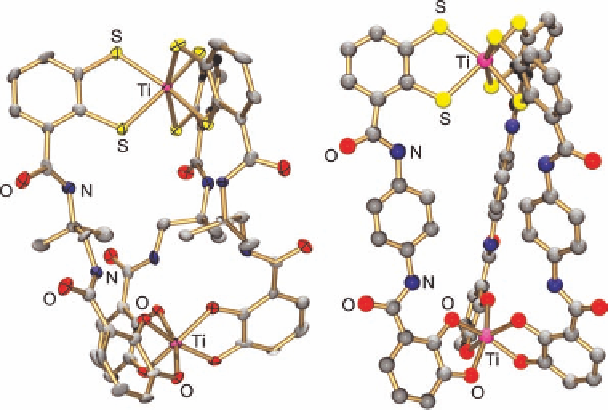Chemistry Reference
In-Depth Information
Molecular structures of the anions [Ti
2
(10)
3
]
4
(left) and [Ti
2
(13)
3
]
4
(right).
Figure 5.16
with a parallel orientation of the ligand strands. A strong downfield shift of the catecho-
ylamide NH proton resonance in the anion [Ti
2
(
10
)
3
]
4
relative to the free ligand H
4
-
10
indicates the formation of strong N
S
hydrogen bonds were detected in the [Ti
2
(
10
)
3
]
4
anion. While NMR spectroscopy
showed that only one pair of stereoisomers (L,D/D,L or L,L/D,D) is present in solution,
an X-ray diffraction study was carried out to show that both metals in the anion
[Ti
2
(
10
)
3
]
4
adopt the same absolute configuration (Figure 5.16, left). Upon crystalliza-
tion, a spontaneous resolution into crystals containing exclusively the L,L or the D,D iso-
mer (space group
P
1) occurred. The unit cell of Na(PNP)
3
[Ti
2
(
10
)
3
] contains one
tetraanion [Ti
2
(
10
)
3
]
4
,threePNP
þ
cations, one sodium cation and additional solvent
molecules. The sodium cation acts as a bridge between two [Ti
2
(
10
)
3
]
4
tetraanions by
coordination of the amide carbonyl functions of two different tetraanions and this leads to
the indefinite polymeric chains Na-[Ti
2
(
10
)
3
]
4
H
O hydrogen bonds, whereas no N
H
[Ti
2
(
10
)
3
]
4
in the solid state.
The reaction of three equivalents of H
4
-
13
with two equivalents of [TiO(acac)
2
]and
Na
2
CO
3
in methanol at room temperature under an argon atmosphere gave a deep red
solution of Na
4
[Ti
2
(
13
)
3
] [49]. As was observed with Na
4
[Ti
2
(
10
)
3
] [29], only three of the
four sodium cations can be substituted with PNP
þ
cations. The ligand strands in Na
(PNP)
3
[Ti
2
(
13
)
3
] are also oriented in a parallel fashion (Figure 5.16, right) and strong
N
Na
O hydrogen bonds were detected by
1
H NMR spectroscopy in solution and by
X-ray crystalography in the solid state. In contrast to the situation in Na(PNP)
3
[Ti
2
(
10
)
3
],
two tetraanions [Ti
2
(
13
)
3
]
4
are connected via a sodium cation that is coordinated by the
three
meta
oxygen atoms of the catecholato groups of each complex tetraanion, thereby
forming a central NaO
6
octahedron in an anionic pentanuclear complex {[Ti
2
(
13
)
3
]
H
Na
[Ti
2
(
13
)
3
]} [49].
The different binding preferences of the donor groups in the benzene-
o
-dithiol/catechol
ligand H
4
-
13
for the selective assembly of a heterobimetallic helical complexes have been

Search WWH ::

Custom Search